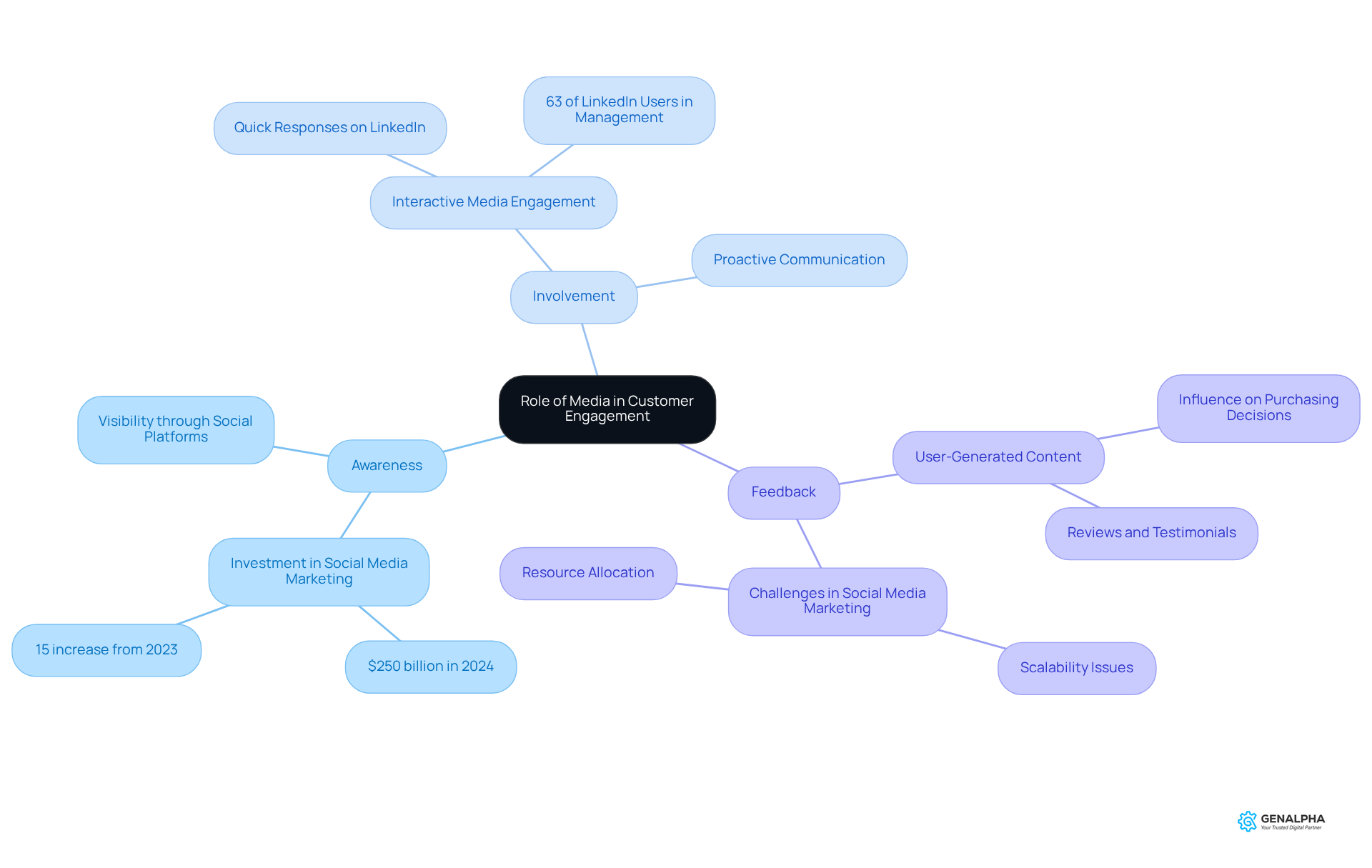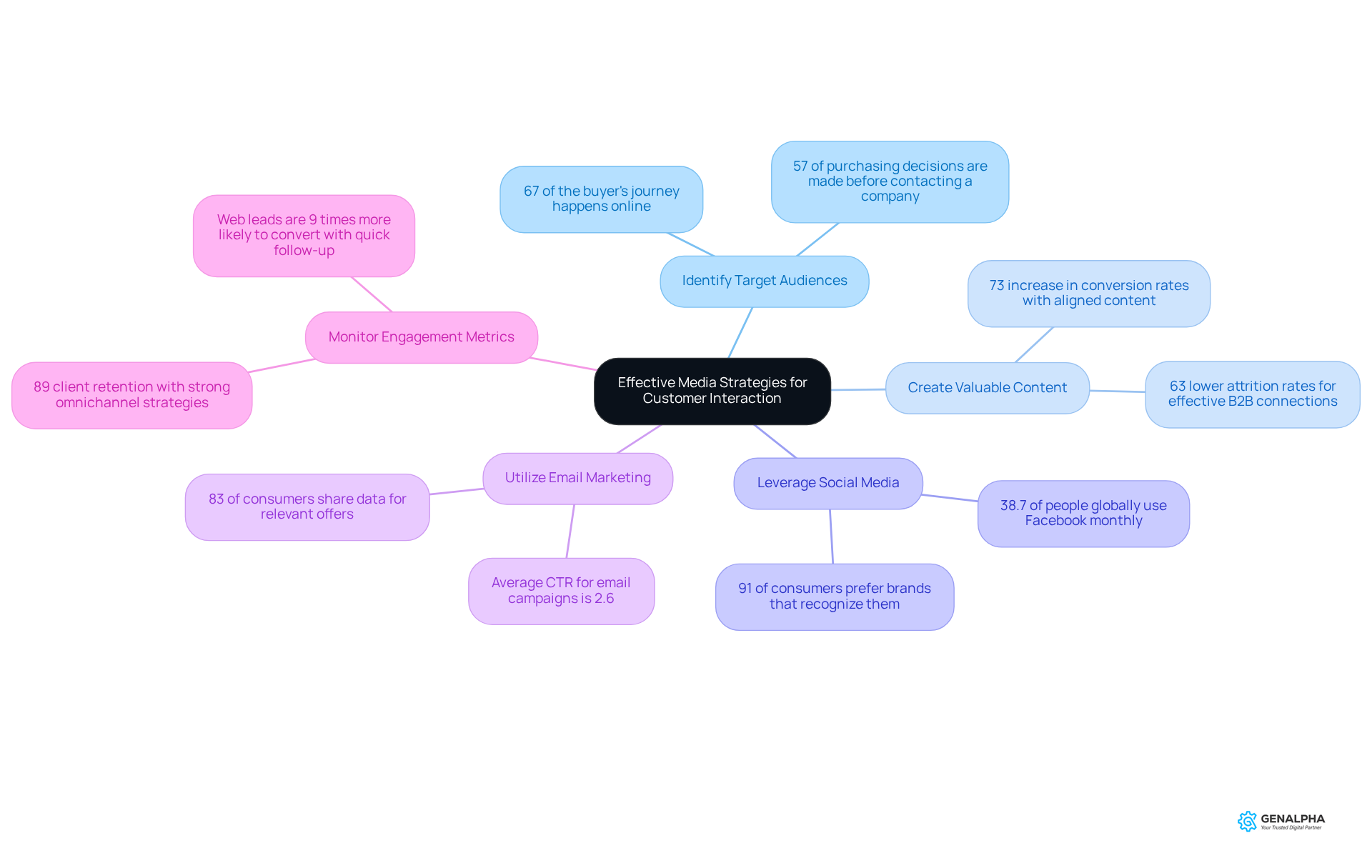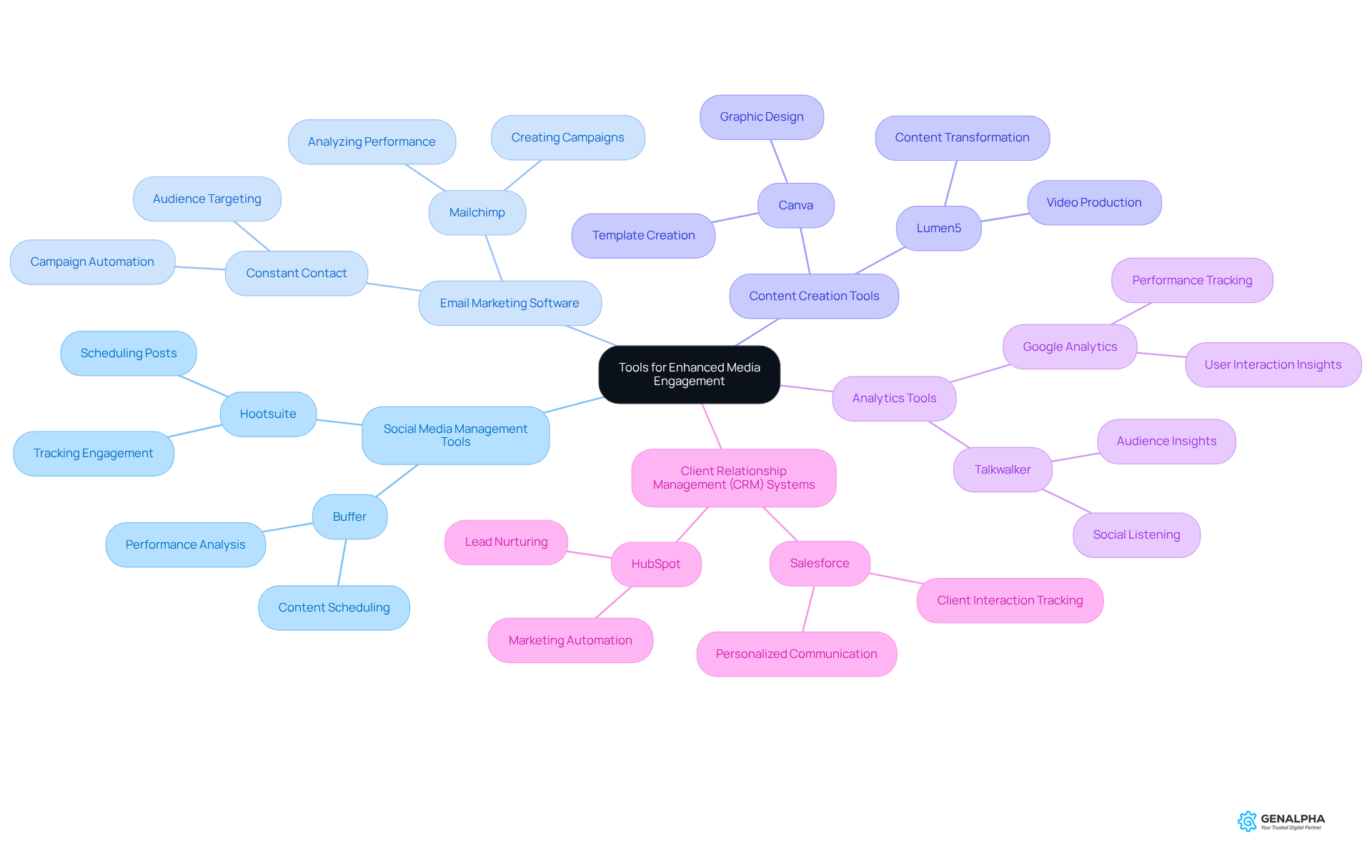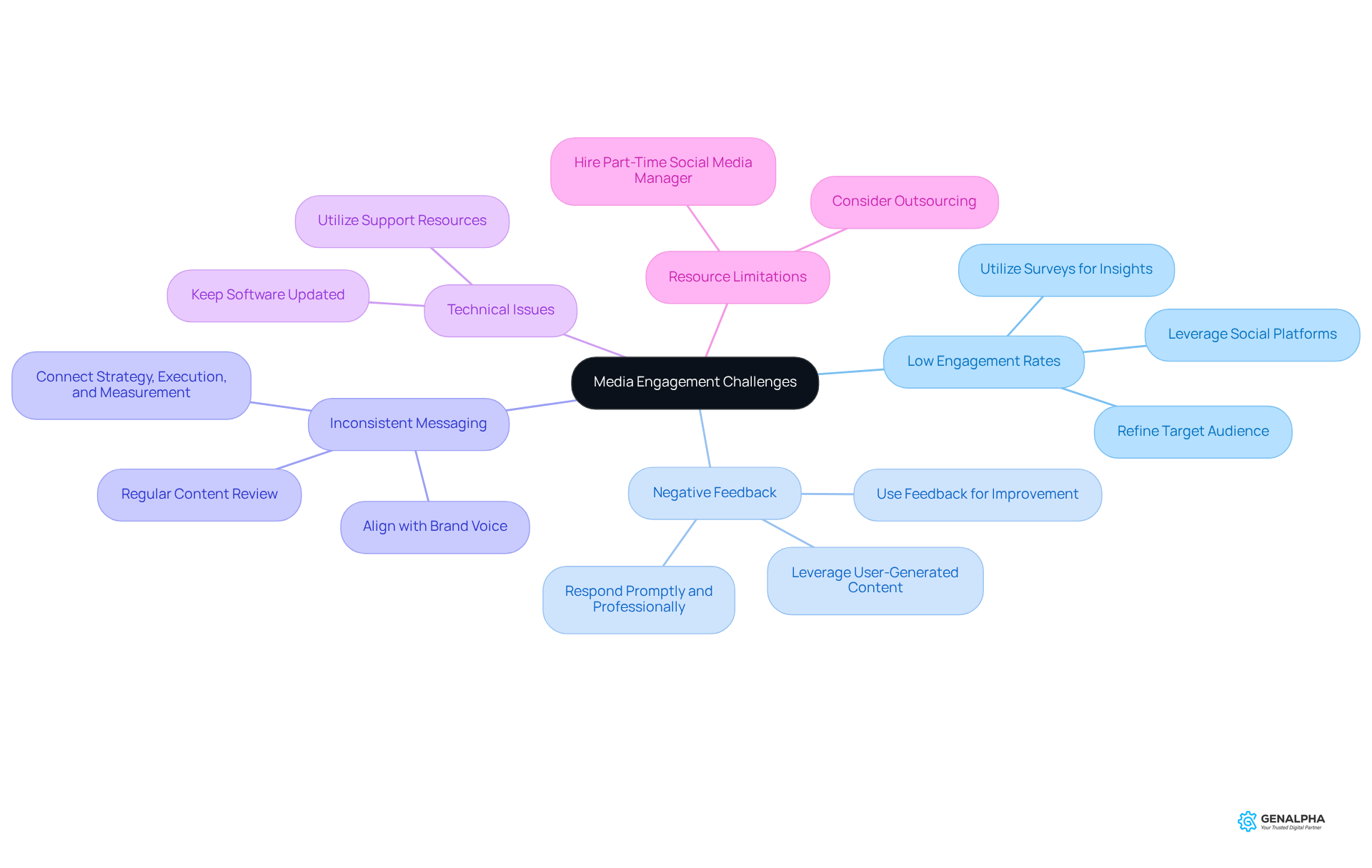Overview
Have you ever wondered how equipment manufacturers can truly connect with their customers? This article dives into the art of media engagement, showing how it can enhance customer interaction and build trust. It’s all about using different media channels, crafting valuable content, and leveraging the right tools to really connect with clients.
For example, did you know that effective media strategies can significantly improve customer experience and retention rates? That’s right! By tapping into the right channels and creating engaging content, manufacturers can transform their customer relationships.
So, what’s the takeaway? Embrace these strategies and watch your customer interactions flourish. Let’s start mastering media engagement together!
Introduction
In a world where communication shapes how we see things, the role of media in engaging customers for equipment manufacturers is more important than ever. This article explores strategies that can help producers make the most of media, turning it from just a communication tool into a powerful way to build relationships.
But as manufacturers work to boost their media presence, they often face challenges that can get in the way. So, what innovative approaches can we adopt to overcome these hurdles and create deeper connections with our clients?
Understand the Role of Media in Customer Engagement
In today’s digital landscape, communication is key to shaping how equipment producers interact with their clients. Have you ever thought about how different channels—like social media, email, and online forums—affect consumer perceptions? Media isn’t just a tool for communication; it’s also a way to build relationships and trust with customers. By recognizing the importance of media, producers can tailor their strategies to meet client expectations more effectively. Let’s break down some key aspects:
- Awareness: Media channels are crucial for creating awareness about products and services, making it easier for customers to find what they’re looking for. For instance, producers that tap into social platforms can significantly boost their visibility. In fact, nearly $250 billion was invested in social media marketing in 2024, reflecting a 15% increase from the previous year.
- Involvement: Interactive media fosters deeper engagement, allowing clients to ask questions and get quick answers. Being proactive on platforms like LinkedIn and Facebook can enhance service and satisfaction. Did you know that 63% of LinkedIn users hold management positions or higher? This makes it a vital platform for connecting with decision-makers.
- Feedback: Media provides an essential space for users to share their experiences, which is invaluable for the improvement of products and services. User-generated content, like reviews and testimonials on social platforms, can significantly influence potential clients’ opinions and purchasing decisions. However, producers also face challenges, such as scalability and resource allocation in their social media marketing efforts.
By understanding these roles and addressing the associated challenges, producers can strategically enhance their communication engagement, ultimately improving client experiences and fostering loyalty. What strategies will you implement to leverage media in your communication efforts?

Implement Effective Media Strategies for Customer Interaction
To effectively engage customers through media, manufacturers should consider a few strategies that really work:
-
Identify Target Audiences: Who are your clients? What media channels do they prefer? Think social media platforms, industry-specific forums, or even email newsletters. This is super important since 67% of the buyer's journey happens online, and by the time individuals interact with a company, 57% of their purchasing decision is already made. So, connecting with clients where they are is essential.
-
Create Valuable Content: Let’s talk about content that really hits home. Develop pieces that address your clients' pain points and interests. This could be blog posts, videos, or infographics that share insights into product usage or industry trends. Captivating content can boost conversion rates by 73% when it aligns with the buyer's journey. Plus, firms that connect effectively with their B2B clients see 63% lower attrition rates, highlighting the long-term benefits of solid interaction strategies.
-
Leverage Social Media: Platforms like LinkedIn and Facebook are goldmines for sharing updates, engaging with customers, and responding to inquiries. Regular interaction can help build a community around your brand. Did you know that 91% of consumers are more likely to shop with brands that recognize and provide relevant offers? And with 38.7% of people globally using Facebook every month, there’s a huge opportunity for audience interaction.
-
Utilize Email Marketing: Don’t underestimate the power of targeted emails! Sending out valuable information, promotions, or updates about new products can make a difference. Personalization is key here—83% of consumers are willing to share their data for offers that matter to them.
-
Monitor Engagement Metrics: Keep an eye on how users interact with your media content. Use analytics tools to assess participation levels and tweak your strategies as needed. Businesses with strong omnichannel interaction strategies retain 89% of their clients, which shows how crucial continuous monitoring and adaptation are.
By applying these tactics, producers can create a more captivating online presence in media that truly connects with their clients. Remember, "73% of companies with above-average customer experience perform better financially than their competitors." This really emphasizes the importance of effective customer interaction. So, what strategy will you try first?

Utilize Tools and Resources for Enhanced Media Engagement
To boost media engagement, manufacturers can tap into a range of handy tools and resources designed just for them.
-
Social Media Management Tools: Think of platforms like Hootsuite and Buffer as your best friends for scheduling posts, tracking engagement, and analyzing performance across various social media channels. These tools are key to keeping a steady online presence. In fact, posting 3-5 times a week is often recommended for optimal engagement. As Aarushi Kushwaha puts it, "Regular and interesting content keeps your manufacturing brand in the minds of prospective clients and partners."
-
Email Marketing Software: Tools such as Mailchimp and Constant Contact make it easy to create, send, and analyze email campaigns. With 75% of B2B purchasers making buying decisions via social media, effective email marketing ensures your messages hit the right audience at just the right time.
-
Content Creation Tools: Platforms like Canva help you design eye-catching graphics, while video editing software like Lumen5 allows you to produce high-quality visual content. Video marketing—especially product demos and client testimonials—has shown to boost credibility and engagement.
-
Analytics Tools: Google Analytics and tools like Talkwalker provide essential insights into user interactions, helping you understand which content resonates best with your audience. This data-driven approach is crucial for refining your marketing strategies and enhancing overall effectiveness.
-
Client Relationship Management (CRM) Systems: A CRM system helps you keep track of client interactions across various channels, allowing for personalized communication and improved service. This integration is key to nurturing leads and building long-lasting relationships.
By using these tools, manufacturers can streamline their media interactions, making them more efficient and focused. This not only fosters growth but also enhances client satisfaction. So, why not give them a try?

Troubleshoot Common Media Engagement Challenges
Producers often face various challenges when interacting with media. Let’s explore some common issues and effective strategies to tackle them:
-
Low Engagement Rates: Is your content not hitting the mark? It might be time to take a closer look at your target audience and refine your messaging. Surveys can be a goldmine for insights into client preferences, helping you craft content that truly resonates. Interestingly, 39% of producers say that social platforms deliver strong results, highlighting the importance of effective engagement tactics.
-
Negative Feedback: How do you handle those not-so-great comments? Responding promptly and professionally is key. Use these moments as opportunities to improve your products or services, showing customers that their feedback is valued. Research shows that 70% of consumers are more likely to stick with a brand that addresses their concerns. Plus, leveraging user-generated content (UGC) can build trust and credibility, making it a smart strategy for managing negative feedback.
-
Inconsistent Messaging: Are your messages all over the place? Consistency across communication channels is vital for maintaining a strong brand identity. Regularly review your content to ensure it aligns with your brand's voice and values—this builds trust and recognition among your audience. As Nathan Harris points out, connecting strategy, execution, and measurement is essential for successful media interaction.
-
Technical Issues: Technical hiccups can really get in the way of effective media interaction. Make sure to utilize the support resources provided by media channels and keep your software and tools updated to avoid compatibility issues that could disrupt your outreach efforts.
-
Resource Limitations: Feeling stretched thin with media interaction? If resources are tight, think about outsourcing to a digital marketing agency or bringing on a part-time social media manager. This can help streamline your efforts and enhance your overall media strategy. Notably, 57% of manufacturing marketers report that a lack of resources is a significant barrier, emphasizing the need for effective solutions.
By proactively addressing these challenges, manufacturers can boost their media presence and engage more effectively with their customers. What steps will you take to enhance your media interactions today?

Conclusion
Mastering media engagement is crucial for equipment manufacturers who want to build stronger customer relationships and boost brand visibility. Have you ever thought about how media plays a multifaceted role—from raising awareness to facilitating feedback? By understanding this, manufacturers can tailor their communication efforts more strategically. Using diverse media channels not only builds trust but also allows producers to connect with clients on a more personal level.
The article highlighted several key strategies to enhance media engagement. These include:
- Identifying target audiences
- Creating valuable content
- Leveraging social media
- Utilizing email marketing
- Monitoring engagement metrics
Each of these tactics is vital for building a solid online presence, which ultimately leads to better customer experiences and increased loyalty. Plus, tackling common challenges like low engagement rates, negative feedback, and inconsistent messaging is essential for maintaining a strong brand identity.
In conclusion, we can't underestimate the importance of effective media engagement; it’s a cornerstone for successful customer interactions in the equipment manufacturing sector. By embracing innovative strategies and using the right tools, manufacturers can overcome obstacles and forge lasting connections with their clients. As the landscape of customer engagement continues to evolve, taking proactive steps to enhance media interactions will be key to thriving in this competitive environment. So, what steps will you take to improve your media engagement?
Frequently Asked Questions
What is the role of media in customer engagement?
Media plays a crucial role in shaping how equipment producers interact with their clients by facilitating communication, building relationships, and establishing trust.
How does media create awareness about products and services?
Media channels are essential for creating awareness, making it easier for customers to discover products and services. For example, social media platforms can significantly boost visibility, with nearly $250 billion invested in social media marketing in 2024.
What is the importance of interactive media?
Interactive media fosters deeper engagement by allowing clients to ask questions and receive quick answers, enhancing service and customer satisfaction. Platforms like LinkedIn and Facebook are particularly effective for proactive engagement.
How does LinkedIn contribute to customer engagement?
LinkedIn is vital for connecting with decision-makers, as 63% of its users hold management positions or higher, making it a strategic platform for producers to engage with influential clients.
What role does feedback play in media engagement?
Media provides a space for users to share their experiences, which is valuable for improving products and services. User-generated content, such as reviews and testimonials, can significantly influence potential clients’ opinions and purchasing decisions.
What challenges do producers face in social media marketing?
Producers encounter challenges such as scalability and resource allocation when implementing their social media marketing efforts.
How can producers enhance their communication engagement?
By understanding the roles of media and addressing associated challenges, producers can strategically improve their communication engagement, ultimately enhancing client experiences and fostering loyalty.




